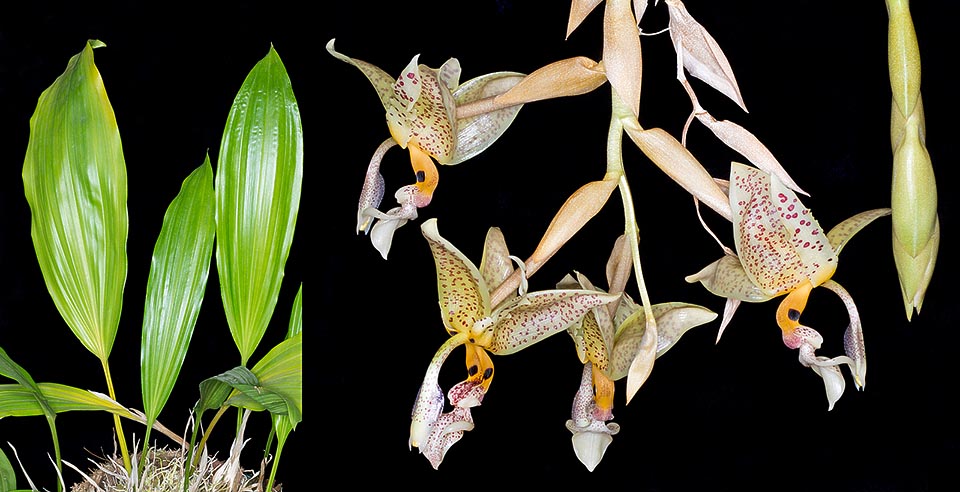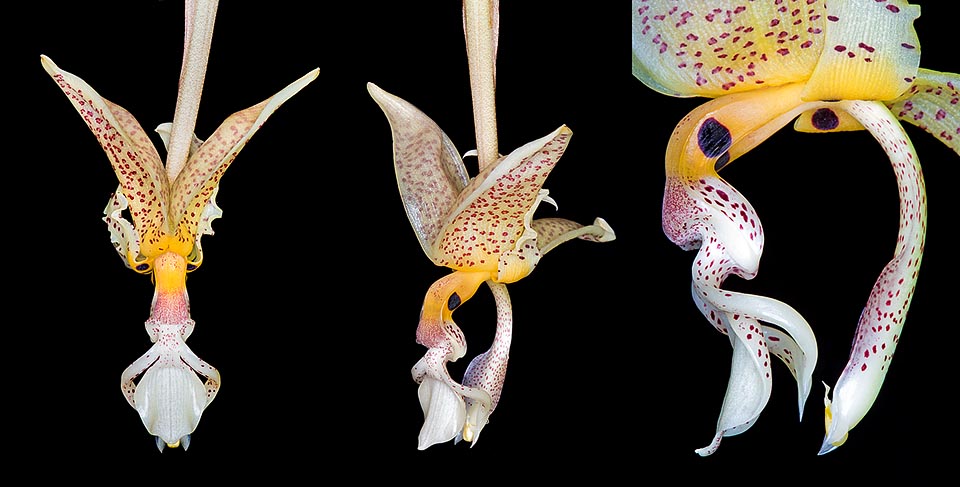Family : Orchidaceae

Text © Pietro Puccio

English translation by Mario Beltramini
The species is native to Belize, El Salvador, Guatemala, Honduras, Mexico (Campeche, Chiapas, Colima, Guerrero, Jalisco, Michoacán, Nayarit, Oaxaca, Quintana Roo, Tabasco, Veracruz and Yucatán) and Nicaragua where it lives on the trees of the humid forests or on rocky crags, between 400 and 2000 m of altitude.
The genus is honoured to Philip Henry Stanhope (1781-1855) who was president of the London Medico-Botanical Society; the specific name is the Latin adjective “oculatus, a, um” = provided of eyes, with reference to the two dark brown spots a the base of the labellum.
Common names: eye-spot Stanhopea (English).
The Stanhopea oculata (Lodd.) Lindl. (1832) is an epiphytic plant, rarely terrestrial, with ovoid pseudobulbs, 3,5-7,5 cm long and 2-4,5 cm of diameter, longitudinally grooved, provided at the apex of one leaf, on a 7-14 cm long petiole, elliptic-lanceolate with pointed apex, plicate, 30-60 cm long and 4-16 cm broad.

Stanhopea oculata is a Central America epiphyte, rarely terrestrial, growing in the humid forests or on rocky slopes, between 400 and 2000 m of altitude. Ovoid pseudobulbs with only one 30-60 cm leaf and odd drooping inflorescences that may reach 30 cm with 5-8 perfumed flowers of 10-12 cm of diameter © Giuseppe Mazza
It reproduces by seed, in vitro, and by division at the vegetative restart, with each section provided of at least 4-5 pseudobulbs.
One of the most appreciated Stanhopea thanks to the large attractive and perfumed flowers, even short-lasting, 5-7 days, characteristic common to the genus, and the facility of cultivation, usually produced in summer-autumn. It requires a partially shady position, intermediate temperatures, 16-28 °C, with lowest winter night values preferably not under the 12 °C, high humidity, 65-85%, and constant ventilation. The waterings must be regular and abundant, but without stagnations, during the growth phase, more spaced during the vegetative stasis, paying attention to never allow the substratum to dry up completely.

Close-up of a flower, shot from various viewpoints, with enlargement of the labellum. The pollination is entrusted to bees of the tribe of the Euglossini © Giuseppe Mazza
The species is reported in the appendix II of CITES (species whose trade is internationally ruled).
Synonyms: Dendrobium grandiflorum Sw. (1829); Ceratochilus oculatus G. Lodd. (1831); Ceratochilus oculatus Lodd. (1832); Stanhopea bucephalus Lindl. (1832); Stanhopea lindleyi Zucc. (1837); Stanhopea oculata var. barkeriana Lindl. (1839); Stanhopea aurantia Lodd. ex P.N.Don (1845); Stanhopea oculata var. aureum Henshall (1845); Stanhopea oculata var. cinnamomum Henshall (1845); Stanhopea oculata var. barkeri Heynh. (1846); Stanhopea oculata var. minor Heynh. (1846); Stanhopea oculata var. meleagris auct. (1851); Stanhopea oculata var. lindleyi (Zucc.) Lindl. (1852); Stanhopea guttata Beer (1854); Stanhopea oculata var. conspicua Regel (1855); Stanhopea guttata K.Koch (1858); Stanhopea oculata var. flava Planch. (1858); Stanhopea oculata var. viridiaurea Planch. (1858); Stanhopea ornatissima Lem. (1862); Stanhopea cymbiformis Rchb.f. (1865); Epidendrum cornutum Sessé & Moc. (1894); Stanhopea oculata var. constricta Klinge (1898); Stanhopea oculata var. geniculata Klinge (1898); Stanhopea minor Schltr. (1917).
→ For general notions about ORCHIDACEAE please click here.
